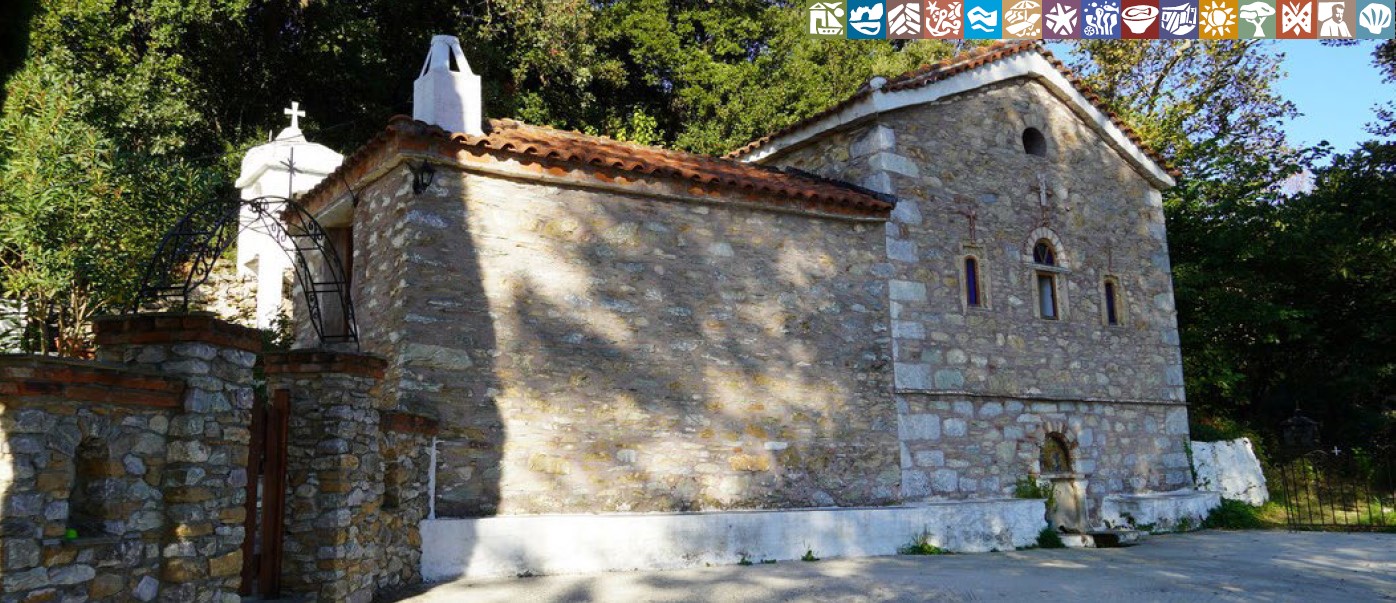
Holy Sites
The relationship between the society of Skiathos and religion is reflected on the holy sites, whether that is the Cathedral with its imposing marble iconostasis or the iconic monastery of Evangelistria with the fortified architecture of Mount Athos or the small modest chapels.
The work of the late Alexis Alexiou “Skiathos, the architecture
of the post-byzantine monuments” was indispensable for
recording and scientifically substantiating the places of
worship in Skiathos.
Most of the churches were built during the post-byzantine era
(1821-1453). Only two belong to a previous era, Agia Triada
(Holy Trinity) and Hagia Sophia in Troulos. The church of Agios
Sozon or Ai Sostis was the only one built in the 19th century
and the rest were of the 20th and 21st century. The postbyzantine
churches and Monasteries are the most interesting
in their characteristics and we can divide them in:
of the post-byzantine monuments” was indispensable for
recording and scientifically substantiating the places of
worship in Skiathos.
Most of the churches were built during the post-byzantine era
(1821-1453). Only two belong to a previous era, Agia Triada
(Holy Trinity) and Hagia Sophia in Troulos. The church of Agios
Sozon or Ai Sostis was the only one built in the 19th century
and the rest were of the 20th and 21st century. The postbyzantine
churches and Monasteries are the most interesting
in their characteristics and we can divide them in:

Two distinct traditions emerge from the churches of Skiathos.
The first, that pertains to nearly all the churches, is native,
folk, austere and affected by the neighbouring Pelion which
is flourishing at the time (enlightenment). The second, richer
in form and more considered, involves elements of the
architecture of the Holy Mount Athos. A typical monument of
this tradition is the Monastery of Evangelistria, the founder
of which came from the Holy Mount. This second tradition
can be seen in the rest of the Sporades as well.

The first, that pertains to nearly all the churches, is native,
folk, austere and affected by the neighbouring Pelion which
is flourishing at the time (enlightenment). The second, richer
in form and more considered, involves elements of the
architecture of the Holy Mount Athos. A typical monument of
this tradition is the Monastery of Evangelistria, the founder
of which came from the Holy Mount. This second tradition
can be seen in the rest of the Sporades as well.
1. Churches of Kastro
Christos sto Kastro (Jesus in Kastro)
The church of the Birth of Christ, or Christos sto Kastro, is
almost in the middle of Kastro, the medieval town of Skiathos.
During the Turkish Rule, a time when the town thrived, it was
the Cathedral of the town. It is the biggest and decoratively
richest church of Kastro, which can be expected considering
Skiathos was the see of the Bishop of Sporades until 1725.
The limited renovations that were taking place from time to
time haven’t really changed the church. Its entrance today
(from a door to the west) is different than the old one that
is nowadays walled in. While the church as a whole is austere
and modest, its walls are adorned by notable murals with
the whole body of Saints or miracles or the life of Saints.
They also stand out for the movement, expressiveness and
proportionality of the shapes they depict. The decorative
elements are similar to the ones in other Aegean islands’
churches that were built by 1700.

The church of the Birth of Christ, or Christos sto Kastro, is
almost in the middle of Kastro, the medieval town of Skiathos.
During the Turkish Rule, a time when the town thrived, it was
the Cathedral of the town. It is the biggest and decoratively
richest church of Kastro, which can be expected considering
Skiathos was the see of the Bishop of Sporades until 1725.
The limited renovations that were taking place from time to
time haven’t really changed the church. Its entrance today
(from a door to the west) is different than the old one that
is nowadays walled in. While the church as a whole is austere
and modest, its walls are adorned by notable murals with
the whole body of Saints or miracles or the life of Saints.
They also stand out for the movement, expressiveness and
proportionality of the shapes they depict. The decorative
elements are similar to the ones in other Aegean islands’
churches that were built by 1700.
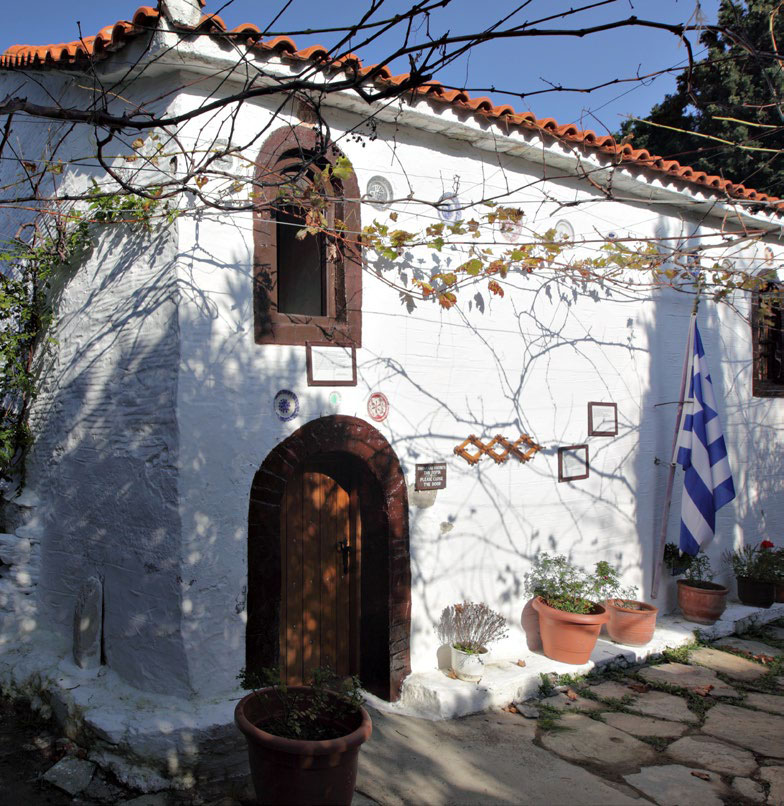
Agia Marina (Saint Marina / Saint Margaret)
Further north and at a higher altitude than Christos sto
Kastro, we can find the church of Agia Marina. The biggest
part of the church today is relatively new because the older
one collapsed for unknown reasons. The ground on which it
stands is very steep. It was built most probably sometime in
the mid18-th century.
Further north and at a higher altitude than Christos sto
Kastro, we can find the church of Agia Marina. The biggest
part of the church today is relatively new because the older
one collapsed for unknown reasons. The ground on which it
stands is very steep. It was built most probably sometime in
the mid18-th century.
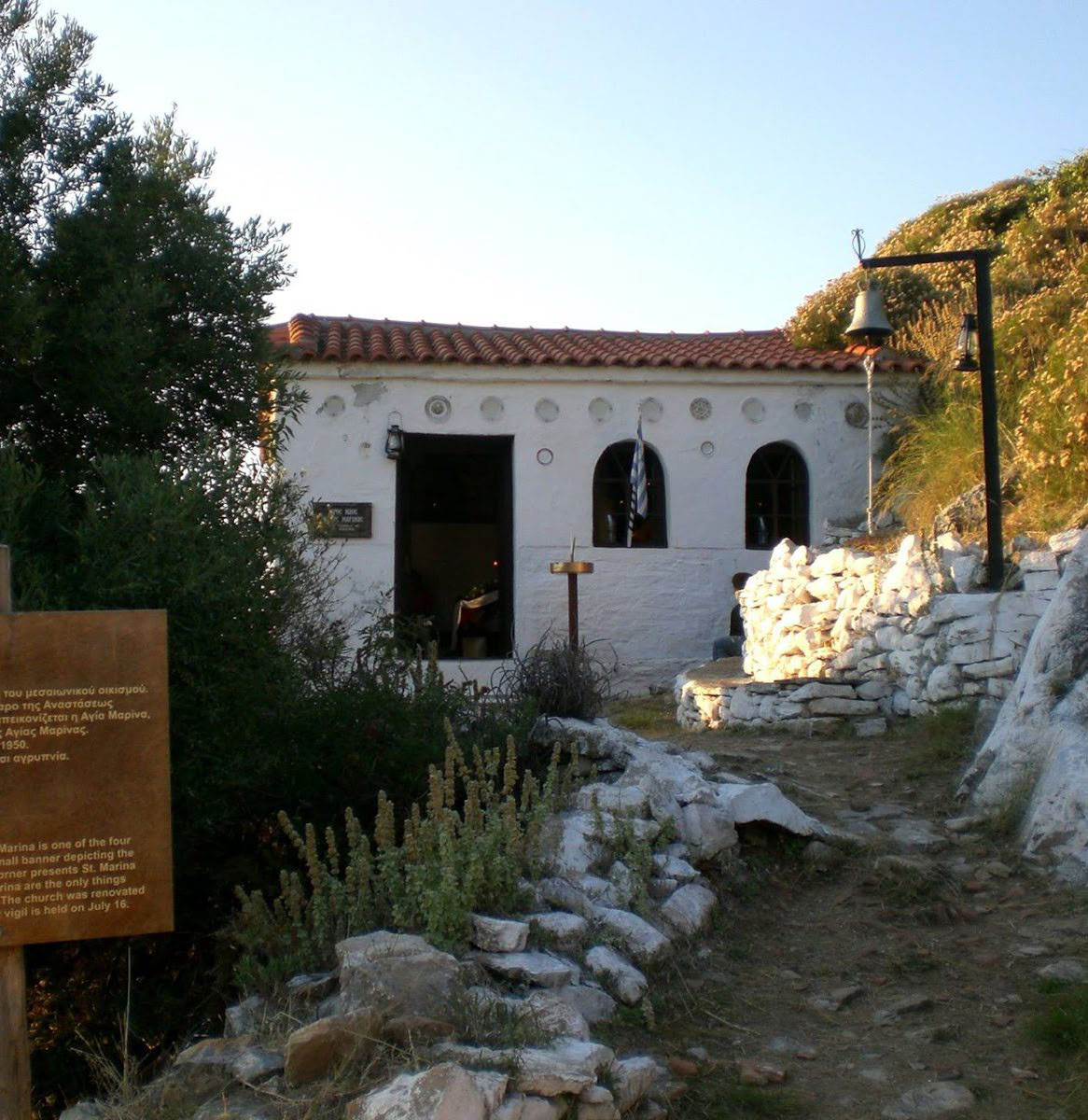
Agios Nikolaos of Kastro (Saint Nicholas)
It is located 100 meters to the west of Christos sto Kastro.
Agios Nikolaos is one of the only three churches of Kastro
(along with Agia Marina and Christos) that hasn’t collapsed.
During the later years of the settlement in Kastro, it was
the parish around which the families of the rich shipowners
gathered. The occasional tampering and renovating didn’t
affect the general characteristics of the church. There is
nothing to attest to the existence of any kind of decoration,
apart from a simple floor design. The construction year is not
established, but it is estimated to be in the 17th century.
A vigil is held in honour of Agios Nikolaos twice a year: on the
5th to 6th of August and on the removal of the relics of the
Saint on the 19th to 20th of May.
It is located 100 meters to the west of Christos sto Kastro.
Agios Nikolaos is one of the only three churches of Kastro
(along with Agia Marina and Christos) that hasn’t collapsed.
During the later years of the settlement in Kastro, it was
the parish around which the families of the rich shipowners
gathered. The occasional tampering and renovating didn’t
affect the general characteristics of the church. There is
nothing to attest to the existence of any kind of decoration,
apart from a simple floor design. The construction year is not
established, but it is estimated to be in the 17th century.
A vigil is held in honour of Agios Nikolaos twice a year: on the
5th to 6th of August and on the removal of the relics of the
Saint on the 19th to 20th of May.
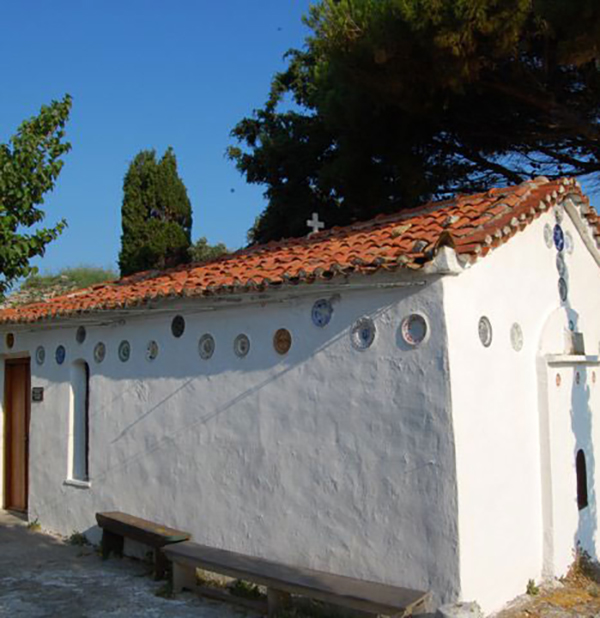
Agios Vasilios (Saint Basil)
Less that 100 meters to the north of the church of Agios
Nikolaos, we can find the remains of the church of Agios
Vasilios, which are often difficult to spot due to the thick
vegetation. It is the only church of Kastro with an entrance
to the north. There is nothing to suggest the existence
of decoration, and the time of erection of the church is
estimated around the 16th to 17th century. It was completely
renovated in 1995. It is celebrated on the 1st of January but
commemorated as a mobile holiday on the second Saturday
after Easter with a Divine Liturgy.
Less that 100 meters to the north of the church of Agios
Nikolaos, we can find the remains of the church of Agios
Vasilios, which are often difficult to spot due to the thick
vegetation. It is the only church of Kastro with an entrance
to the north. There is nothing to suggest the existence
of decoration, and the time of erection of the church is
estimated around the 16th to 17th century. It was completely
renovated in 1995. It is celebrated on the 1st of January but
commemorated as a mobile holiday on the second Saturday
after Easter with a Divine Liturgy.

Panagia Prekla (Virgin Mary “Prekla”)
The remains of a church can be found a few meters before and
to the south of Christos sto Kastro, close to the Mosque of the
old town. At the base of these ruins one can barely make out
the traces of murals. This is Panagia Prekla, which according
to some elements that are saved (like the icon of Panagia the
infant-cradling -Panagia Prekla-), was brilliant, potentially giving
it its name: “preclarus” meaning “bright, noble, splendid” in
Latin. It was most probably constructed sometime between the
end of the 16th century and the beginning of the 17th.
An entire novel by Papadiamantis (“Remvasmos tou
Dekapentavgoustou”) takes place in the church of Panagia
Prekla. Nowadays, an outdoor vigil is held on the Saturday after
the 15th of August, which is the day of Dormition of the Mother
of God, one of the greatest days for the Eastern Church.
The remains of a church can be found a few meters before and
to the south of Christos sto Kastro, close to the Mosque of the
old town. At the base of these ruins one can barely make out
the traces of murals. This is Panagia Prekla, which according
to some elements that are saved (like the icon of Panagia the
infant-cradling -Panagia Prekla-), was brilliant, potentially giving
it its name: “preclarus” meaning “bright, noble, splendid” in
Latin. It was most probably constructed sometime between the
end of the 16th century and the beginning of the 17th.
An entire novel by Papadiamantis (“Remvasmos tou
Dekapentavgoustou”) takes place in the church of Panagia
Prekla. Nowadays, an outdoor vigil is held on the Saturday after
the 15th of August, which is the day of Dormition of the Mother
of God, one of the greatest days for the Eastern Church.
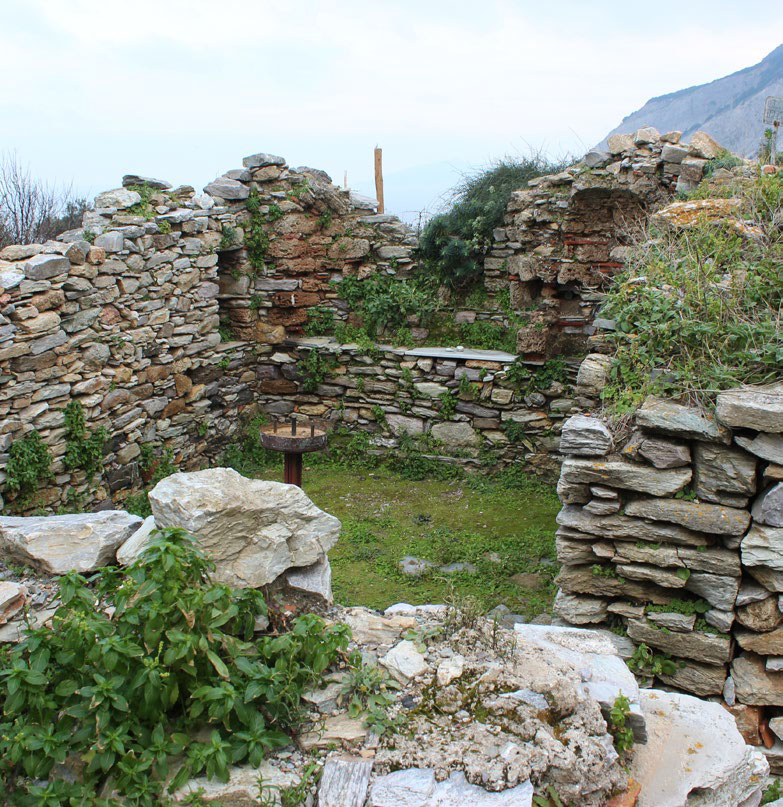
Panagia Megalomata of Kastro (Virgin Mary of Large Eyes)
The ruins of Panagia Megalomata are located about 100
meters to the west of Christos sto Kastro. Its name comes
from an archaic icon of the church that showed Panagia having
masculine features and very large eyes. As with Agios Vasilios,
the ruins are difficult to spot. Its masonry is of a lower
quality than that of other churches of Kastro and no traces of
decoration can be found. Its construction is estimated to be of
the 17th or 18th century.
Alexandros Papadiamantis mentions the church is one of his
novels (“Ta krousmata”).
The ruins of Panagia Megalomata are located about 100
meters to the west of Christos sto Kastro. Its name comes
from an archaic icon of the church that showed Panagia having
masculine features and very large eyes. As with Agios Vasilios,
the ruins are difficult to spot. Its masonry is of a lower
quality than that of other churches of Kastro and no traces of
decoration can be found. Its construction is estimated to be of
the 17th or 18th century.
Alexandros Papadiamantis mentions the church is one of his
novels (“Ta krousmata”).

Agia Kiriaki (Saint Kyriaki)
The remains of the church of Agia Kiriaki are located close to
the most northern part of Kastro, under Barberaki - the peak
of Kastro - on the spot where the cannon of Anagkià can still
be found today. The church dates back to the 17th century. It
should also be noted that, according to Papadiamantis, there
seems to have been a church of Agia Kiriaki outside Kastro. So,
there either were two homonymous churches or the church
in Kastro is dedicated to another Saint and the Church of Agia
Kiriaki outside Kastro doesn’t exist anymore.
The remains of the church of Agia Kiriaki are located close to
the most northern part of Kastro, under Barberaki - the peak
of Kastro - on the spot where the cannon of Anagkià can still
be found today. The church dates back to the 17th century. It
should also be noted that, according to Papadiamantis, there
seems to have been a church of Agia Kiriaki outside Kastro. So,
there either were two homonymous churches or the church
in Kastro is dedicated to another Saint and the Church of Agia
Kiriaki outside Kastro doesn’t exist anymore.

Agioi Apostoloi (Saint Apostles)
The ruins of the church of Agioi Apostoloi can be found a few
meters westward of Panagia Prekla. We have no evidence to
attest to the existence or not of decoration. We can assume
based on other churches of Kastro that the church was built
during the 17th century.
The ruins of the church of Agioi Apostoloi can be found a few
meters westward of Panagia Prekla. We have no evidence to
attest to the existence or not of decoration. We can assume
based on other churches of Kastro that the church was built
during the 17th century.
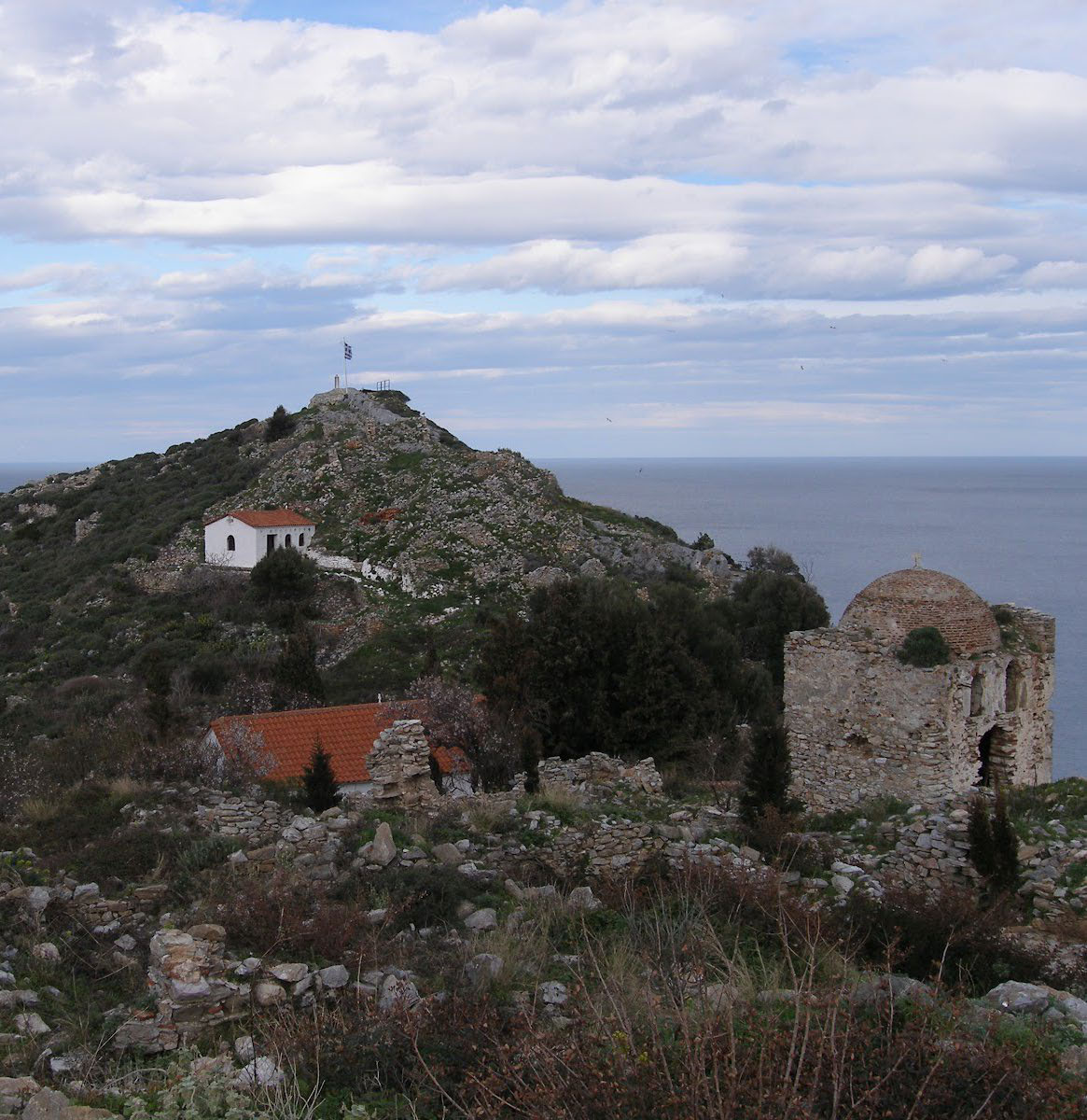
Agios Dimitrios outside of Kastro (Saint Demetrius)
On the north of Skiathos, half a kilometre before Kastro and
next to the road that leads to it, there are some ruins that
probably belong to the church of Agios Dimitrios. There are
many ruins all around the area, which point to the existence
of a settlement. The entrance is located in the middle of the
west wall, deviating from the rest of the churches of Kastro
that are entered from their south wall. The only mention
of the existence of this church can be found in a novel of
Papadiamantis. It is considered a construction of the 17th or
the beginning of the 18th century.
On the north of Skiathos, half a kilometre before Kastro and
next to the road that leads to it, there are some ruins that
probably belong to the church of Agios Dimitrios. There are
many ruins all around the area, which point to the existence
of a settlement. The entrance is located in the middle of the
west wall, deviating from the rest of the churches of Kastro
that are entered from their south wall. The only mention
of the existence of this church can be found in a novel of
Papadiamantis. It is considered a construction of the 17th or
the beginning of the 18th century.
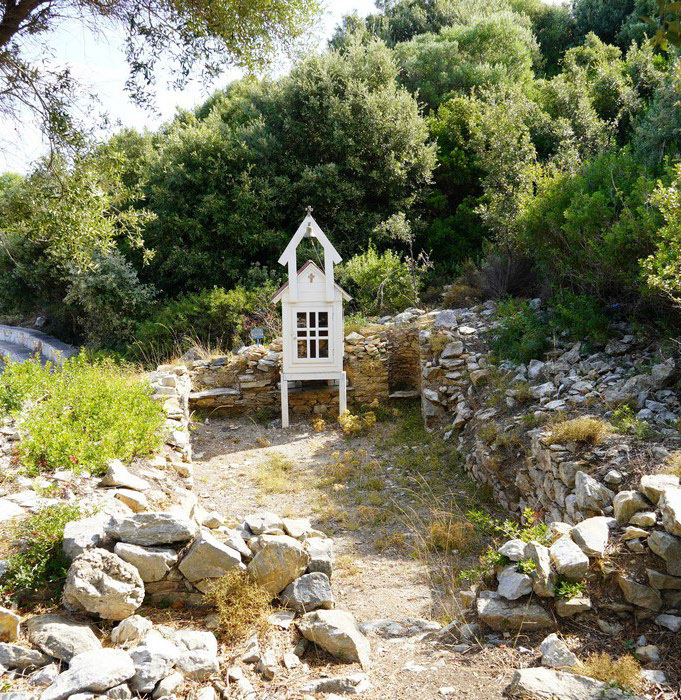
Catholicon of the Monastery of Evangelismos / Panagia sto
Kalami Outside Of Kastro (Monastery of the Annunciation
/ Virgin Mary in Kalami)
On the northeast of Kastro, after the bay where the stream
“Doman” flows into, higher than the remains of the watermill
of Kastro, perched on the rocky slope we can find ruins that
attest to the existence of life of yesteryear. These ruins
belong to the small monastery of “Evangelismos of Kastro” or
“Panagia sto Kalami” or “Panagia Kastriotissa”.
Due to the inaccessibility of the area and the fact that it’s
been more than two centuries since the abandonment of
the Monastery, its existence is still unknown to many locals.
Another reason for that is the founding of the new monastery
of Evangelismos in Agalianou (Monastery of Evangelistria) in
1797 which overshadowed all others.

Kalami Outside Of Kastro (Monastery of the Annunciation
/ Virgin Mary in Kalami)
On the northeast of Kastro, after the bay where the stream
“Doman” flows into, higher than the remains of the watermill
of Kastro, perched on the rocky slope we can find ruins that
attest to the existence of life of yesteryear. These ruins
belong to the small monastery of “Evangelismos of Kastro” or
“Panagia sto Kalami” or “Panagia Kastriotissa”.
Due to the inaccessibility of the area and the fact that it’s
been more than two centuries since the abandonment of
the Monastery, its existence is still unknown to many locals.
Another reason for that is the founding of the new monastery
of Evangelismos in Agalianou (Monastery of Evangelistria) in
1797 which overshadowed all others.
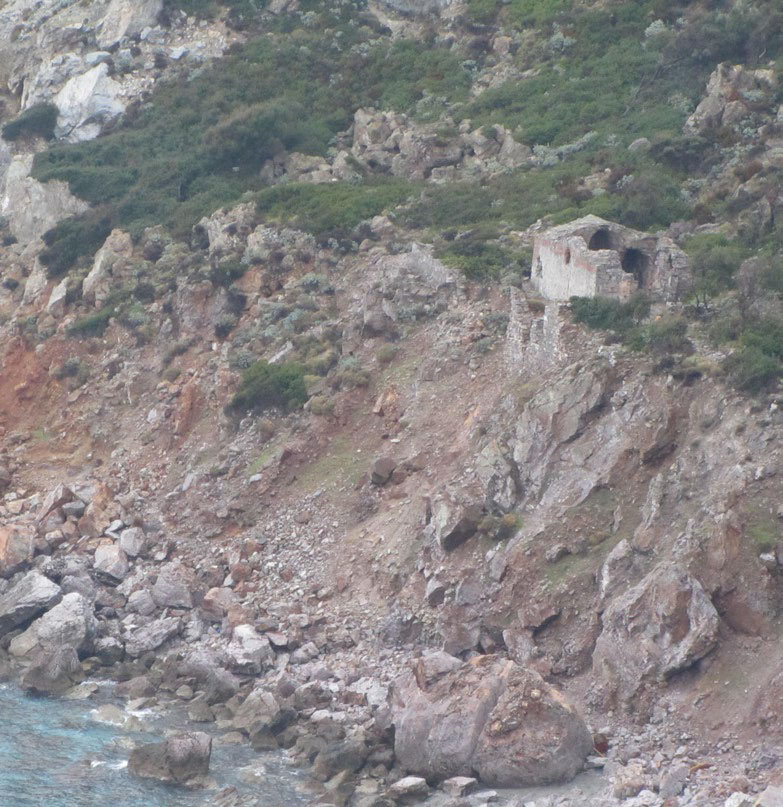
2. Churches of the modern town
Agios Nikolaos (Saint Nicholas)
The church of Agios Nikolaos Thalassinos (of the sea) or
Agios Nikolaos in Kotronia is located in the modern town of
Skiathos, above the new port. Its year of construction cannot
be established but the icon of Agios Nikolaos -that belonged
to the altarpiece of the church and today is housed in the
Three Holy Hierarchs Church- is of 1807, so the church must
have been built before the 19th century.
On the 19th of May vespers are held and in the morning of the
20th a Divine Liturgy.
The beautiful courtyard of the church is ideal for a moment of
pause to admire the panoramic views of the port of Skiathos.
There can also be found an impressive clock, a hallmark, one
of the first things to be seen from visitors approaching the
harbour.
The church of Agios Nikolaos Thalassinos (of the sea) or
Agios Nikolaos in Kotronia is located in the modern town of
Skiathos, above the new port. Its year of construction cannot
be established but the icon of Agios Nikolaos -that belonged
to the altarpiece of the church and today is housed in the
Three Holy Hierarchs Church- is of 1807, so the church must
have been built before the 19th century.
On the 19th of May vespers are held and in the morning of the
20th a Divine Liturgy.
The beautiful courtyard of the church is ideal for a moment of
pause to admire the panoramic views of the port of Skiathos.
There can also be found an impressive clock, a hallmark, one
of the first things to be seen from visitors approaching the
harbour.
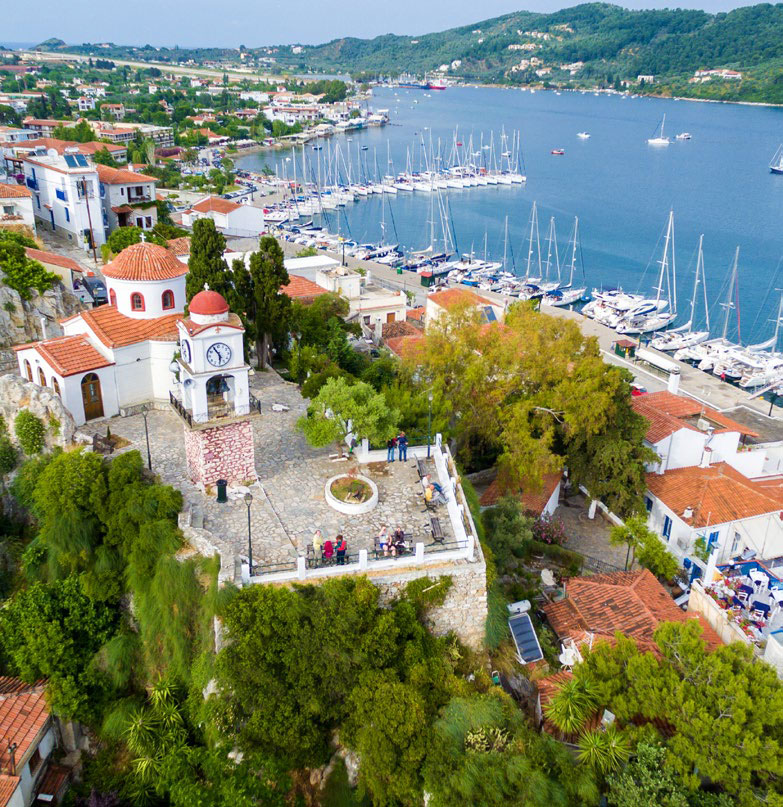
Panagia Limnia – Parish Church of the Nativity of Mary
The Nativity of Mary or Panagia Limnia was built after
the Greek revolution of 1821. This church and the Three
Holy Hierarchs church are the only noteworthy religious
monuments to be built after the settlement of the residents
of Skiathos in the modern town in 1829, in places where
churches preexisted. It is called “Limnia” because the first
inhabitants of the area where the church is, and founders of
the church, came from the area Limni in Euboea.
In 1784, people from Limni settled in the area bringing with
them the icon of their patron saint, the Nativity of Mary. They
put the icon in the small church of Agios Charalambos which
was later completely renovated and become the Parish Church
of Panagia Limnia.

The Nativity of Mary or Panagia Limnia was built after
the Greek revolution of 1821. This church and the Three
Holy Hierarchs church are the only noteworthy religious
monuments to be built after the settlement of the residents
of Skiathos in the modern town in 1829, in places where
churches preexisted. It is called “Limnia” because the first
inhabitants of the area where the church is, and founders of
the church, came from the area Limni in Euboea.
In 1784, people from Limni settled in the area bringing with
them the icon of their patron saint, the Nativity of Mary. They
put the icon in the small church of Agios Charalambos which
was later completely renovated and become the Parish Church
of Panagia Limnia.
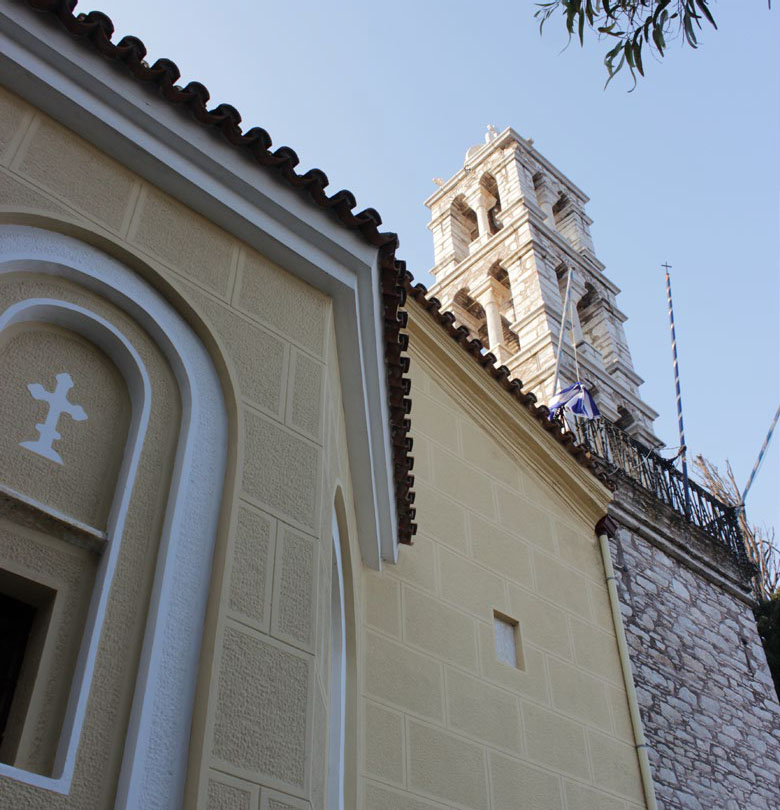
Three Holy Hierarchs Church
The other parish church of Skiathos is celebrated in the
memory of the Three Hierarchs and it has been the Cathedral
of the modern town of Skiathos for more than 150 years. It is
located almost in the exact centre of the town and closer to
the sea than the church of Panagia is. At the spot where it was
built there was a small church, dedicated as well to the Three
Hierarchs. That church was knocked down to be replaced by
today’s majestic structure that was built to accommodate the
more than 2000 residents of that time.
Its marble iconostasis is a rare and excellent specimen of
gothic revival in Greece. Its form, albeit incompatible with
the wood carvings traditionally found in orthodox churches,
doesn’t seem foreign but, instead, it is an integral part of the
decoration of the church, in a way enforcing its presence.

The other parish church of Skiathos is celebrated in the
memory of the Three Hierarchs and it has been the Cathedral
of the modern town of Skiathos for more than 150 years. It is
located almost in the exact centre of the town and closer to
the sea than the church of Panagia is. At the spot where it was
built there was a small church, dedicated as well to the Three
Hierarchs. That church was knocked down to be replaced by
today’s majestic structure that was built to accommodate the
more than 2000 residents of that time.
Its marble iconostasis is a rare and excellent specimen of
gothic revival in Greece. Its form, albeit incompatible with
the wood carvings traditionally found in orthodox churches,
doesn’t seem foreign but, instead, it is an integral part of the
decoration of the church, in a way enforcing its presence.
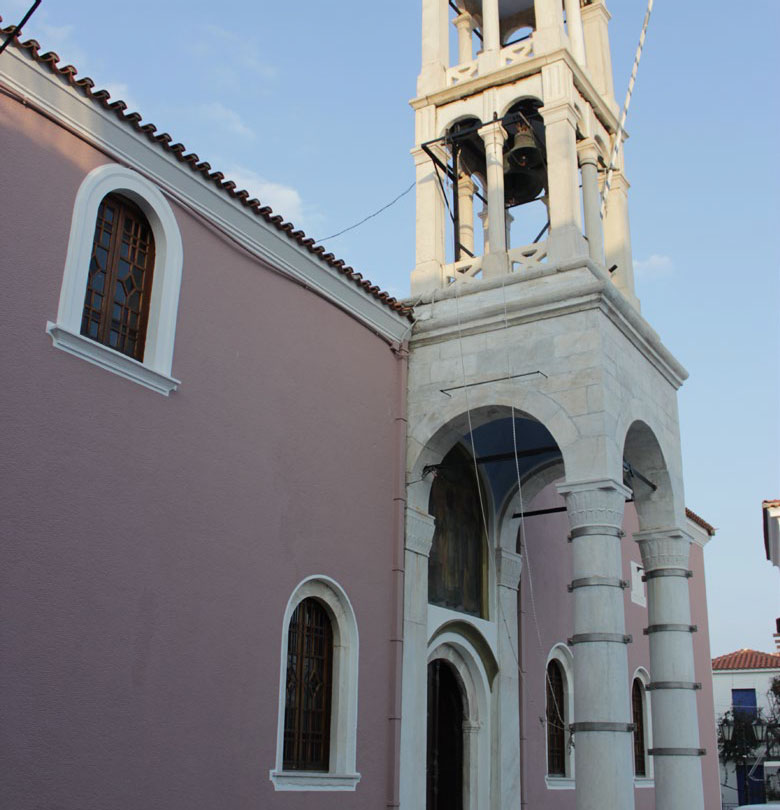
3. Monasteries and Catholicons of monasteries
Monastery of Evangelistria - Holy Cenobitic Monastery of the Annunciation
The commanding Monastery of Evangelistria (or Vagelistra,
as locals call it) can be found on the northeast of the island,
under Karaflitzanaka, the summit of Skiathos. It is built on an
altitude of about 200 meters, in the area “Agalianoi”, on the
top of the creek of Lechouni, 5 km of the town of Skiathos.
Among the oldest Monasteries of Greece, it is the only
“active” monastery of Skiathos.
All Monasteries of Skiathos were built on private initiative
to accommodate the needs of the few. The Monastery of
Evangelistria was a result of collective initiative of people with
specific building standards and a building plan to meet the
needs of a big number of people (there have been references
to 70). Evangelistria was built by Kollyvades monks of the
Holy Mount Athos. It was a rigorous Monastery that banned
entrance to women and followed all the strict regulations of
the Holy Mount.

The commanding Monastery of Evangelistria (or Vagelistra,
as locals call it) can be found on the northeast of the island,
under Karaflitzanaka, the summit of Skiathos. It is built on an
altitude of about 200 meters, in the area “Agalianoi”, on the
top of the creek of Lechouni, 5 km of the town of Skiathos.
Among the oldest Monasteries of Greece, it is the only
“active” monastery of Skiathos.
All Monasteries of Skiathos were built on private initiative
to accommodate the needs of the few. The Monastery of
Evangelistria was a result of collective initiative of people with
specific building standards and a building plan to meet the
needs of a big number of people (there have been references
to 70). Evangelistria was built by Kollyvades monks of the
Holy Mount Athos. It was a rigorous Monastery that banned
entrance to women and followed all the strict regulations of
the Holy Mount.

Holy Monastery of The Presentation of The Blessed Virgin
Mary - Panagia Iconistra
The Monastery of Panagia Iconistra can be found on the most pine-covered area in the west part of Skiathos, 13 kilometres off the town, at 200 meters altitude. It is on the road leading to Mikros Aselinos, one of the northwest coasts of the island. The Monastery of Iconistra is the holiest part of the island since it was there that the miraculous Icon of Panagia was found in 1650. The locals call the Monastery “Kounistra” (the moving one), as the Icon of Panagia was found by hieromonk Symeon dangling off a pine branch. Panagia Iconistra is the patron-saint of Skiathos, celebrated on the 21st of November, and guarded today at the Three Holy Hierarchs Church.

Mary - Panagia Iconistra
The Monastery of Panagia Iconistra can be found on the most pine-covered area in the west part of Skiathos, 13 kilometres off the town, at 200 meters altitude. It is on the road leading to Mikros Aselinos, one of the northwest coasts of the island. The Monastery of Iconistra is the holiest part of the island since it was there that the miraculous Icon of Panagia was found in 1650. The locals call the Monastery “Kounistra” (the moving one), as the Icon of Panagia was found by hieromonk Symeon dangling off a pine branch. Panagia Iconistra is the patron-saint of Skiathos, celebrated on the 21st of November, and guarded today at the Three Holy Hierarchs Church.

Agios Ioannis Krifos - Parthenis (Saint John Concealed)
In an area of the northwest of Skiathos full of pines, close to
the Monastery of Iconistra, in Mikros Aselinos, there used to
be a small monastery. What’s left of it today is the catholicon
-celebrated on the birth of Agios Ioannis Prodromos-, remains
of its surrounding walls and three deserted monastic cells. It
is located on an altitude of 150 meters, and it’s known to the
locals as “Ai Giannis Kryfos” (due to its remote location) or “Ai
Giannis of Partheni (Parthenis was the name of the Skiathian
monk that according to tradition was the founder of the
Monastery).

In an area of the northwest of Skiathos full of pines, close to
the Monastery of Iconistra, in Mikros Aselinos, there used to
be a small monastery. What’s left of it today is the catholicon
-celebrated on the birth of Agios Ioannis Prodromos-, remains
of its surrounding walls and three deserted monastic cells. It
is located on an altitude of 150 meters, and it’s known to the
locals as “Ai Giannis Kryfos” (due to its remote location) or “Ai
Giannis of Partheni (Parthenis was the name of the Skiathian
monk that according to tradition was the founder of the
Monastery).
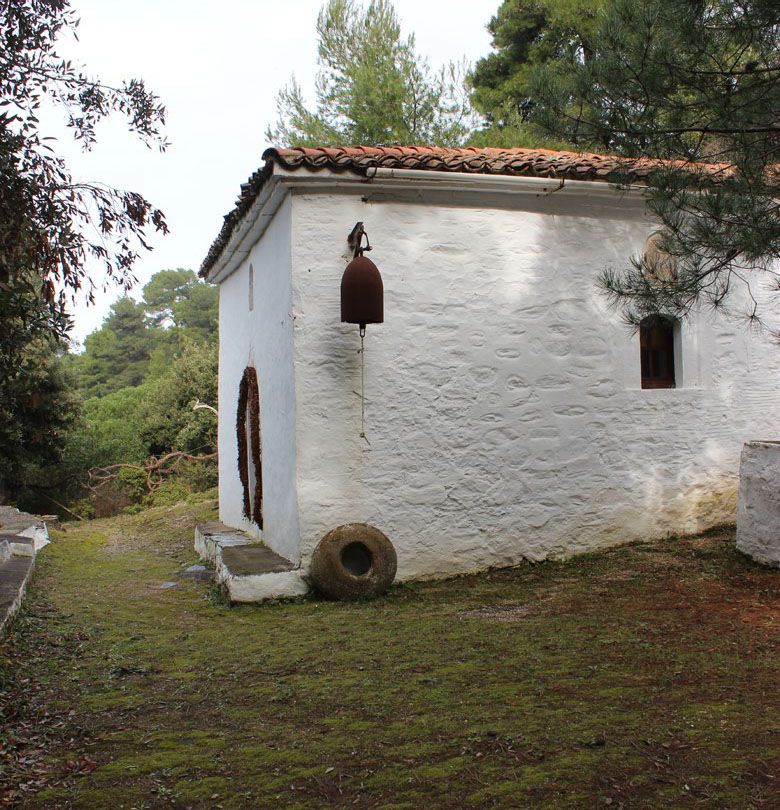
Holy Monastery of Panagia Kechria
The deserted monastery of Panagia Kechria is named after
the area where it’s located: on the northwest, at an altitude of
100 meters, at the slope of Aradias which is covered in olive
and plane trees. To reach the Monastery one has to climb
the hill of Agios Konstantinos and then descend towards the
stream of Kechria.
The Monastery is built in dedication to the dormition of
Panagia and it is celebrated on the 23rd of August. It is a listed
building, under the protection of the Ministry for Culture. The
first lines of the poem “At Panagia Kechria” by Papadiamantis
are devoted to the beauty of nature around the monastery
and the lovely dome of the catholicon. Closer to the medieval
town than the modern one, the monastery thrived alongside
it and experienced the problems the locals were facing during
the Turkish rule.

The deserted monastery of Panagia Kechria is named after
the area where it’s located: on the northwest, at an altitude of
100 meters, at the slope of Aradias which is covered in olive
and plane trees. To reach the Monastery one has to climb
the hill of Agios Konstantinos and then descend towards the
stream of Kechria.
The Monastery is built in dedication to the dormition of
Panagia and it is celebrated on the 23rd of August. It is a listed
building, under the protection of the Ministry for Culture. The
first lines of the poem “At Panagia Kechria” by Papadiamantis
are devoted to the beauty of nature around the monastery
and the lovely dome of the catholicon. Closer to the medieval
town than the modern one, the monastery thrived alongside
it and experienced the problems the locals were facing during
the Turkish rule.

Holy Monastery of Agios Charalambos
The abandoned Monastery of Agios Charalambos in on
the north side 5 kilometres off Skiathos town, on the area
“Kakorema” at an altitude of 300 metres. On the road
of Profitis Ilias Church, there is a sign leading up to the
Monastery, however the road past the sign is a dirt one.
It’s one of the oldest Monasteries of the island that was home
to a small number of monks, without any special structures
and cut-off from the settlements of Skiathos (Kastro, new
town). The buildings must have been constructed during the
Turkish rule, potentially around the 18th century, with some
sections possibly being even older than that. Their forms and
construction are very simple. Some documents prove that the
Monastery and its catholicon were there before 1809. There is
not interior or exterior decoration or any traces to point to an
existence of such at any point.

The abandoned Monastery of Agios Charalambos in on
the north side 5 kilometres off Skiathos town, on the area
“Kakorema” at an altitude of 300 metres. On the road
of Profitis Ilias Church, there is a sign leading up to the
Monastery, however the road past the sign is a dirt one.
It’s one of the oldest Monasteries of the island that was home
to a small number of monks, without any special structures
and cut-off from the settlements of Skiathos (Kastro, new
town). The buildings must have been constructed during the
Turkish rule, potentially around the 18th century, with some
sections possibly being even older than that. Their forms and
construction are very simple. Some documents prove that the
Monastery and its catholicon were there before 1809. There is
not interior or exterior decoration or any traces to point to an
existence of such at any point.
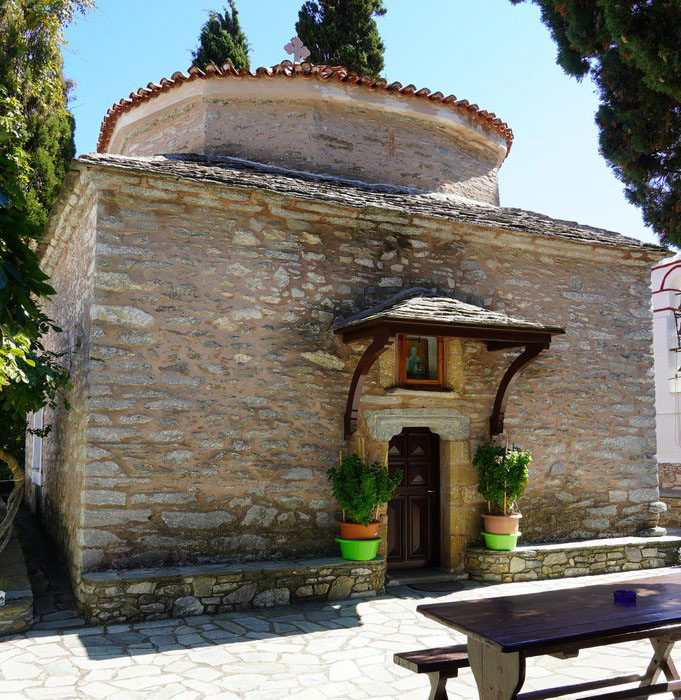
4. Other Churches
None of the small chapels of Skiathos are “orphans” … It is quite moving that a lot of families have affectionately “adopted” a chapel which they care for and celebrate on
the commemoration day of the Saint in honour of which the chapel was built.
the commemoration day of the Saint in honour of which the chapel was built.
Agios Ioannis Krifos - Paschalay (Saint John Concealed)
The church of Ai Giannis Krifos is located 3 kilometres west of the
town of Skiathos, on the creek of Acheelà and celebrated on the
day of finding the Holy Skull of Agios Ioannis Prodromos. Today,
the only thing to be found there is a church and a cell. The name
“Krifos” was given to the church because of its location, in a thick
forest with tall pine trees which made the church visible just a few
steps before you reach it. “Paschalay”, its other attribute, because
that was the name of the family under the care of which the
church was re-constructed after the desertion of the monastery
during the era of the Regency Council.

The church of Ai Giannis Krifos is located 3 kilometres west of the
town of Skiathos, on the creek of Acheelà and celebrated on the
day of finding the Holy Skull of Agios Ioannis Prodromos. Today,
the only thing to be found there is a church and a cell. The name
“Krifos” was given to the church because of its location, in a thick
forest with tall pine trees which made the church visible just a few
steps before you reach it. “Paschalay”, its other attribute, because
that was the name of the family under the care of which the
church was re-constructed after the desertion of the monastery
during the era of the Regency Council.

Profitis Elias (The Church Of The Prophet Elijah)
Under Karaflitzanaka, the tallest summit of the island, north
of the town of Skiathos at an altitude of 300 meters, we
find the church of Profitis Elias, or “Ai-Liàs” as the locals and
Papadiamantis refer to it.
The structure has seen a series of renovations that altered
its original form. There is nothing to prove the existence
of sculptures or paintings in its decoration. Regarding its
construction year, the church was in its second construction
phase in 1758, without ruling out that it was a building of the
byzantine era.
Nowadays, a vigil is held on the eve of the Prophet’s
commemoration day (20th of July). Its spring is also a point of
reference for the locals as they use it quite often to satisfy their
needs in potable water.

Under Karaflitzanaka, the tallest summit of the island, north
of the town of Skiathos at an altitude of 300 meters, we
find the church of Profitis Elias, or “Ai-Liàs” as the locals and
Papadiamantis refer to it.
The structure has seen a series of renovations that altered
its original form. There is nothing to prove the existence
of sculptures or paintings in its decoration. Regarding its
construction year, the church was in its second construction
phase in 1758, without ruling out that it was a building of the
byzantine era.
Nowadays, a vigil is held on the eve of the Prophet’s
commemoration day (20th of July). Its spring is also a point of
reference for the locals as they use it quite often to satisfy their
needs in potable water.
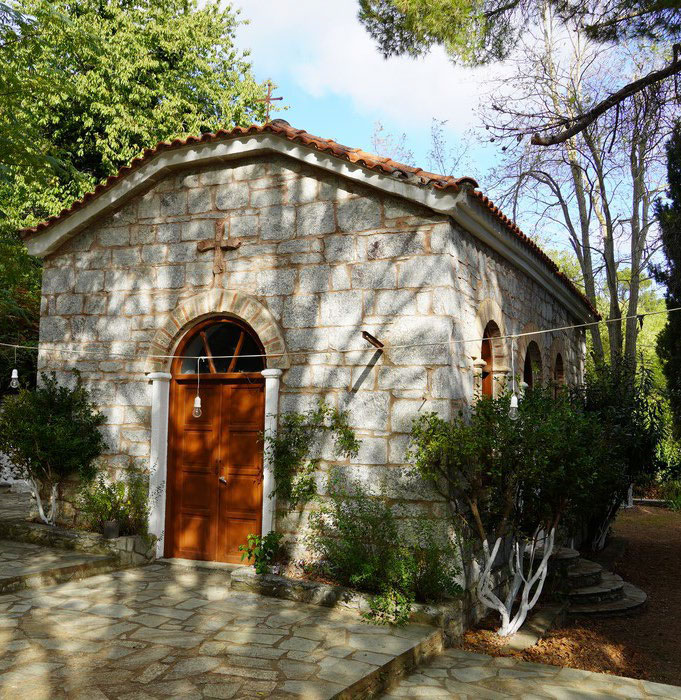
Agios Athanasios (Saint Athanasius)
It is located on the south of Karaflitzanaka, the tallest peak of
the island, close to the spring of Profitis Elias with the plane
trees, at an altitude of about 400 meters. The look of the church
today is a product of many renovations and repairs. It’s a simple
building with white walls with no particular morphological or
decorative elements. The oldest date to be found regarding the
construction is that on the inscription of the renovation: 1899.
Thus, the only thing that’s certain is that it is a monument of
the Turkish rule era, without excluding the possibility due to
adjacency that it was constructed at the same time as Ai-Liàs.
It is located on the south of Karaflitzanaka, the tallest peak of
the island, close to the spring of Profitis Elias with the plane
trees, at an altitude of about 400 meters. The look of the church
today is a product of many renovations and repairs. It’s a simple
building with white walls with no particular morphological or
decorative elements. The oldest date to be found regarding the
construction is that on the inscription of the renovation: 1899.
Thus, the only thing that’s certain is that it is a monument of
the Turkish rule era, without excluding the possibility due to
adjacency that it was constructed at the same time as Ai-Liàs.

Ton Taxiarchon (of The Brigadiers) in Agalianou
The church Ton Taxiarchon in Agalianou is on the north, on the
road leading to the Monastery of Evangelistria at an altitude
of about 200 meters. Its lack of decoration is obvious and is
partly due to the renovations the church underwent at times.
The church’s construction was done relatively meticulously.
The oldest mention of it is in 1796, when the church along
with the vineyards, fields etc is dedicated to the “new”
Monastery of Evangelistria.
The spring of the Taxiarchon is a point of reference for the
island. its crystal-clear fresh water is used by the locals to
cover their everyday needs in potable water.
The church Ton Taxiarchon in Agalianou is on the north, on the
road leading to the Monastery of Evangelistria at an altitude
of about 200 meters. Its lack of decoration is obvious and is
partly due to the renovations the church underwent at times.
The church’s construction was done relatively meticulously.
The oldest mention of it is in 1796, when the church along
with the vineyards, fields etc is dedicated to the “new”
Monastery of Evangelistria.
The spring of the Taxiarchon is a point of reference for the
island. its crystal-clear fresh water is used by the locals to
cover their everyday needs in potable water.

Agios Konstantinos (Saint Constantine)
This church can be found on the hill it gave its name to, on the
northwest of the town, close to Ai-Liàs at an altitude of about
400 meters. The renovations it has at times gone through
were mainly of its roof, thus the appearance of the church
hasn’t been altered.
The only inscription found that would aid in the dating of the
church is the one above the entrance and it references the
renovation of 1899. Nonetheless, in the church there is an old
icon of Agioi Konstantinos and Eleni (Saint Constantine and
Helena) of 1721.
This church can be found on the hill it gave its name to, on the
northwest of the town, close to Ai-Liàs at an altitude of about
400 meters. The renovations it has at times gone through
were mainly of its roof, thus the appearance of the church
hasn’t been altered.
The only inscription found that would aid in the dating of the
church is the one above the entrance and it references the
renovation of 1899. Nonetheless, in the church there is an old
icon of Agioi Konstantinos and Eleni (Saint Constantine and
Helena) of 1721.
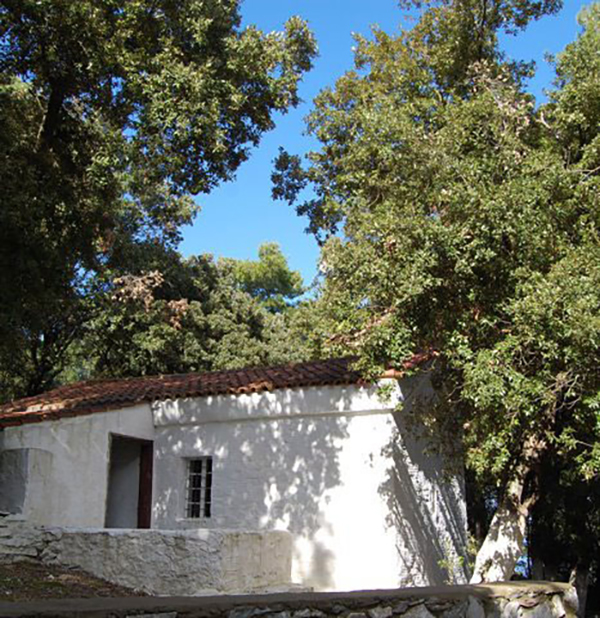
Agios Georgios (Saint George) at the Stream of Kechria
On the north of the island, high up the stream of Kechria
amidst the olive trees, there are some ruins that belong to a
small church built in the honour of Agios Georgios. Nowadays,
only the walls are preserved and there is no trace of internal
or external decoration, or anything to indicate the existence
of any type of art. It was a small chapel like the thousands
that can be found in the Greek countryside. It’s a building of
the era of the Turkish rule.
On the north of the island, high up the stream of Kechria
amidst the olive trees, there are some ruins that belong to a
small church built in the honour of Agios Georgios. Nowadays,
only the walls are preserved and there is no trace of internal
or external decoration, or anything to indicate the existence
of any type of art. It was a small chapel like the thousands
that can be found in the Greek countryside. It’s a building of
the era of the Turkish rule.

Agios Panteleimonas (Saint Pantaleon - The All- Compassionate)
The church of Agios Panteleimonas can be found 1,5
kilometres west of Kastro, on its namesake location, 50
meters higher than the sea. On the outside it looks more like
a hut than a chapel. It has clearly been damaged by the repairs
and renovations it has gone through and it’s impossible to tell
if it had any type of decoration. It’s a building of the era of the
Turkish rule.
The church of Agios Panteleimonas can be found 1,5
kilometres west of Kastro, on its namesake location, 50
meters higher than the sea. On the outside it looks more like
a hut than a chapel. It has clearly been damaged by the repairs
and renovations it has gone through and it’s impossible to tell
if it had any type of decoration. It’s a building of the era of the
Turkish rule.

Panagia Glykofilousa
(Virgin Mary of the Sweet Embrace / Kiss)
Panagia Glykofilousa is on the north end of the island, close
to Kastro, deep on a precipice by the sea. The small chapel
is honoured on the day of the Congregation for Virgin Mary,
the 26th of August. Due to its size, it gives the impression of
a small farmhouse. There is no internal or external decoration
but through a description by Papadiamantis we know that
there were small plates on the exterior walls -perhaps similar
to the ones in the catholicons of Panagia Kechria or Iconistraand
murals of saints in the interior. The appearance of the
church hasn’t changed by the occasional renovation or repair.
It is considered a building of the era of the Turkish rule or
possibly of an even earlier time.
(Virgin Mary of the Sweet Embrace / Kiss)
Panagia Glykofilousa is on the north end of the island, close
to Kastro, deep on a precipice by the sea. The small chapel
is honoured on the day of the Congregation for Virgin Mary,
the 26th of August. Due to its size, it gives the impression of
a small farmhouse. There is no internal or external decoration
but through a description by Papadiamantis we know that
there were small plates on the exterior walls -perhaps similar
to the ones in the catholicons of Panagia Kechria or Iconistraand
murals of saints in the interior. The appearance of the
church hasn’t changed by the occasional renovation or repair.
It is considered a building of the era of the Turkish rule or
possibly of an even earlier time.
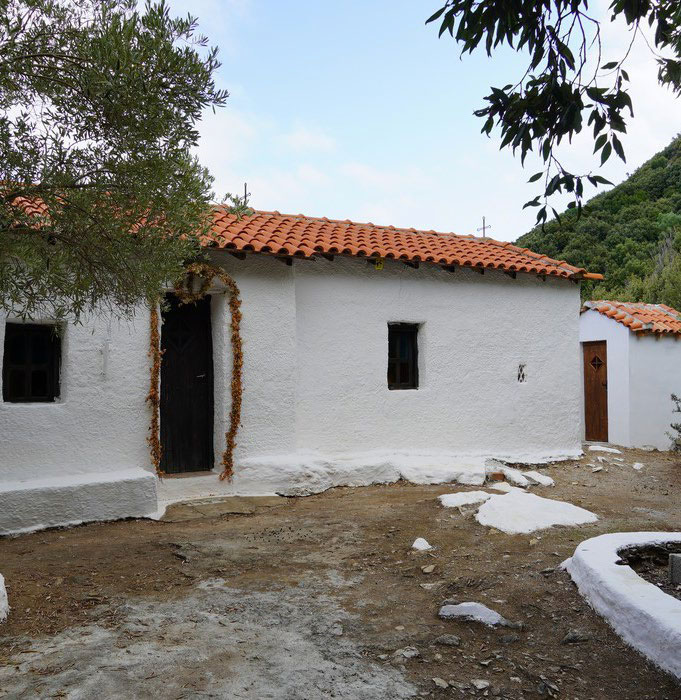
Panagia Kardasi
On the north part of the island, on the way to Kastro, at an
altitude of 200 meters, in the area called “Pryi (Pyrgi)”, there
used to be a church honoured on the day of the Nativity
of Mary and on Saint Anna’s day. According to tradition,
the residents of Kastro, in order to avoid the pirates’ raids,
created a small settlement and constructed the initial
church which was destroyed by a fire at the end of the 19th
century. The one built in its place is honoured on the day of
the Dormition of the Mother of God and it is different than
the old one, so the elements of the initial construction are
not known. The old church, according to Papadiamantis, had
murals which were destroyed by the fire. Today there are
no traces of the decoration of the original church which was
probably constructed around 1770.
On the north part of the island, on the way to Kastro, at an
altitude of 200 meters, in the area called “Pryi (Pyrgi)”, there
used to be a church honoured on the day of the Nativity
of Mary and on Saint Anna’s day. According to tradition,
the residents of Kastro, in order to avoid the pirates’ raids,
created a small settlement and constructed the initial
church which was destroyed by a fire at the end of the 19th
century. The one built in its place is honoured on the day of
the Dormition of the Mother of God and it is different than
the old one, so the elements of the initial construction are
not known. The old church, according to Papadiamantis, had
murals which were destroyed by the fire. Today there are
no traces of the decoration of the original church which was
probably constructed around 1770.

Panagia Doman
The church of Zoodoxos Pigi (Life-giving font) -or Panagia
Doman, as the locals call it- is on the north of the island, close to
Kastro at an altitude of about 200 meters. It’s built amidst wild
vegetation, somewhat lower than the head of the Doman creak
wherefrom it took its name. The modern building is a result of
the 1909 renovation (which was essentially a rebuilding).
The church of Zoodoxos Pigi (Life-giving font) -or Panagia
Doman, as the locals call it- is on the north of the island, close to
Kastro at an altitude of about 200 meters. It’s built amidst wild
vegetation, somewhat lower than the head of the Doman creak
wherefrom it took its name. The modern building is a result of
the 1909 renovation (which was essentially a rebuilding).
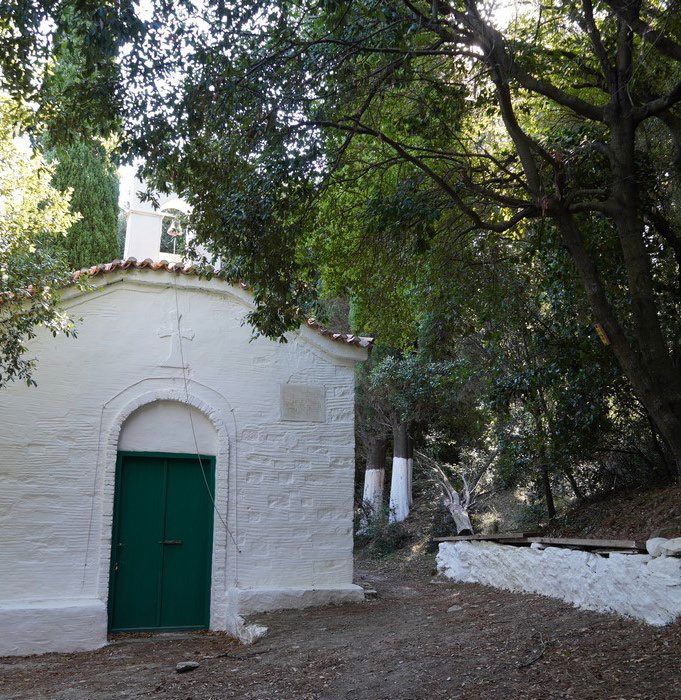
Agios Dimitrios (Saint Demetrius)
The church of Agios Dimitrios is located on the hill of Varantas,
roughly 2 kilometres north of the town, at an altitude of about
300 meters. It is next to the old path that led to the town of
Kastro, surrounded by trees and thus hidden to those passing by.
It is a simple, unadorned church build in the 18th century.
The church of Agios Dimitrios is located on the hill of Varantas,
roughly 2 kilometres north of the town, at an altitude of about
300 meters. It is next to the old path that led to the town of
Kastro, surrounded by trees and thus hidden to those passing by.
It is a simple, unadorned church build in the 18th century.
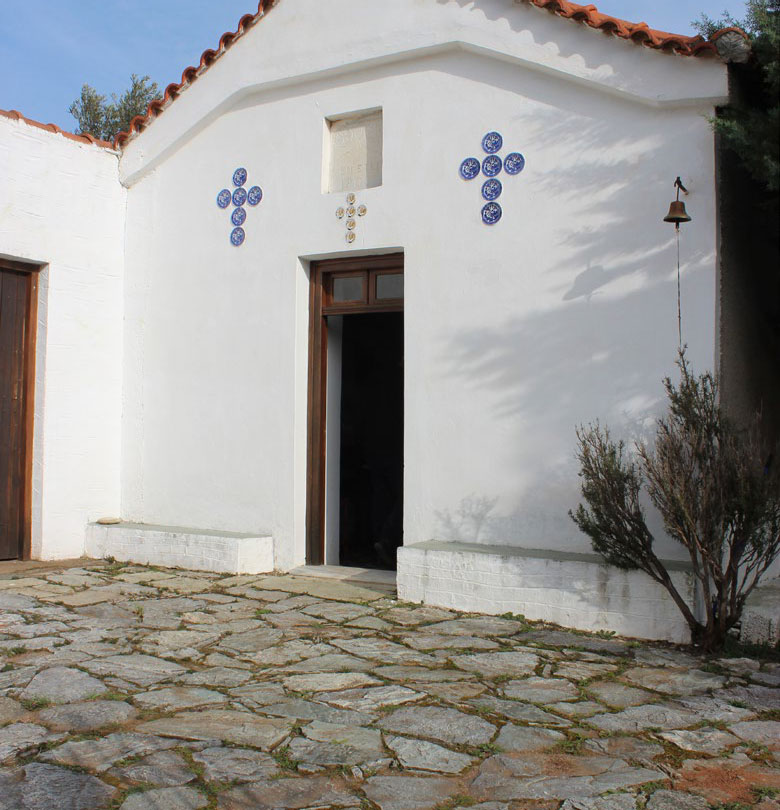
Agios Georgios (Saint George) Christodoulitsa
It is located at about 3 kilometres north of the town of
Skiathos within an olive grove. It is concealed from the
onlookers because of its small dimensions and that fact that
it doesn’t look like a church. It was constructed in the 18th
century or before.
It is located at about 3 kilometres north of the town of
Skiathos within an olive grove. It is concealed from the
onlookers because of its small dimensions and that fact that
it doesn’t look like a church. It was constructed in the 18th
century or before.

Agia Kali
1 kilometre north of the town of Skiathos, at an altitude of
about 100 metres, there are some remains that belong to a
small church, unknown to most locals. This church is Agia Kali
which was built in the 18th century or before.
1 kilometre north of the town of Skiathos, at an altitude of
about 100 metres, there are some remains that belong to a
small church, unknown to most locals. This church is Agia Kali
which was built in the 18th century or before.
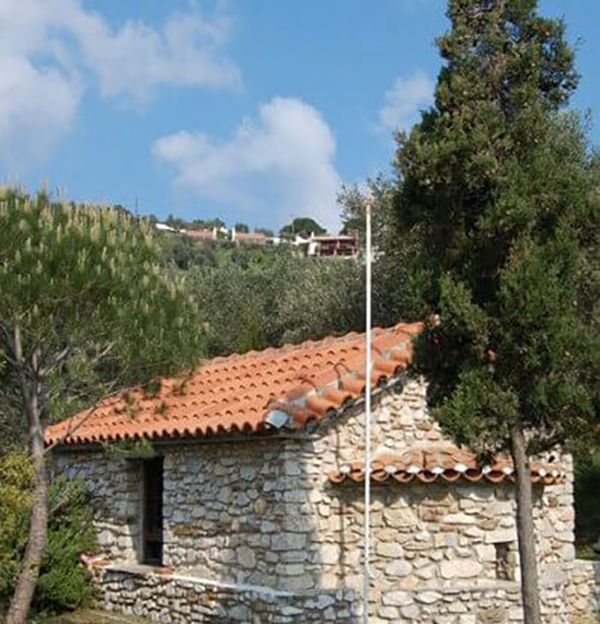
Agios Antonios (Saint Anthony)
The church of Agios Antonios is located on the namesake
hillock, west and not that far from the town. Its appearance
today is affected by the renovation of 1978, which took place
because the church got destroyed by a fire. It most probably
maintained its original form and was constructed during the
Turkish rule.
The church of Agios Antonios is located on the namesake
hillock, west and not that far from the town. Its appearance
today is affected by the renovation of 1978, which took place
because the church got destroyed by a fire. It most probably
maintained its original form and was constructed during the
Turkish rule.
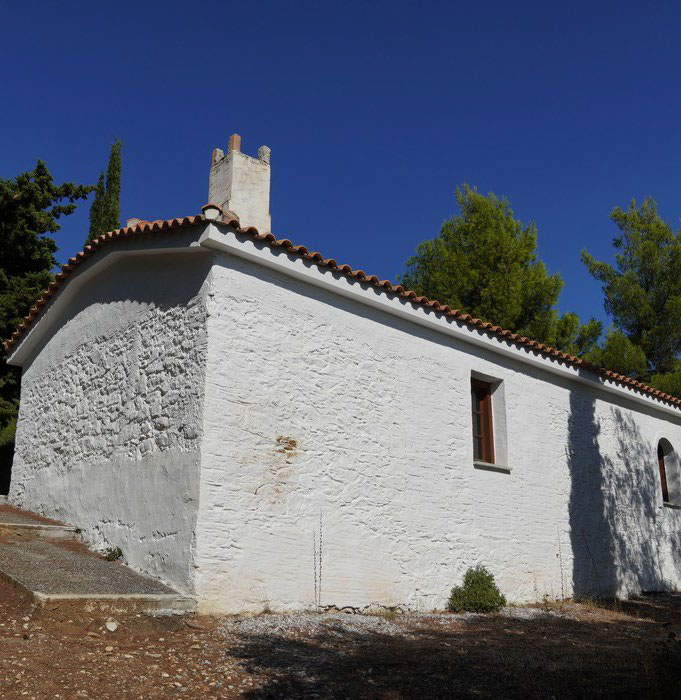
Agios Ioannis Theologos
(Saint John the Theologian) in Pyrgos
The church is built on the northeast of the town, in the
location “Pyrgos” across the entrance to the airport.
According to a historical text, it started to be constructed by
the Monastery of Evangelistria in 1820 but because of the
revolution of 1821 works were postponed until 1838.
(Saint John the Theologian) in Pyrgos
The church is built on the northeast of the town, in the
location “Pyrgos” across the entrance to the airport.
According to a historical text, it started to be constructed by
the Monastery of Evangelistria in 1820 but because of the
revolution of 1821 works were postponed until 1838.
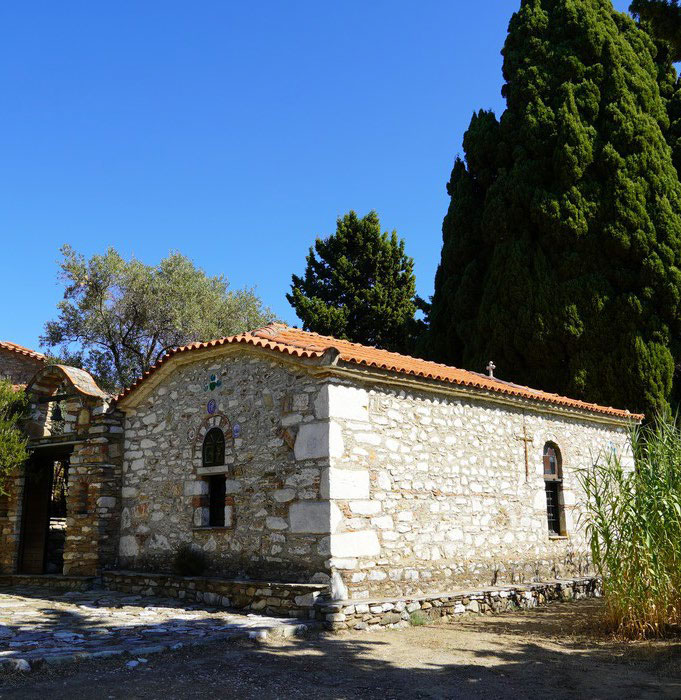
Ton Asomaton (of the Incorporeals) in Achladies
At the most southern part of the island, after the coast of
Vasilias, in Achladies, a few meters above the sea, there is
the church of Taxiarchon or as it’s more commonly known of
“Asomaton in Achladies”. It’s in the middle of an olive grove
and looks more like a farmhouse than a church. It was built
during the Turkish rule era.
At the most southern part of the island, after the coast of
Vasilias, in Achladies, a few meters above the sea, there is
the church of Taxiarchon or as it’s more commonly known of
“Asomaton in Achladies”. It’s in the middle of an olive grove
and looks more like a farmhouse than a church. It was built
during the Turkish rule era.

Agia Eleni (Saint Helena)
The church of Agia Eleni gave its name to the nearby beach,
on the west coast of the island, close to the Strofylia lake in
Koukounaries. The year of construction is not known but the
building stands on the foundations of an older one. What
is also not known is when and why the original structure
collapsed. The modern church could have been built before
1841 and the original one during the Turkish rule.
The church of Agia Eleni gave its name to the nearby beach,
on the west coast of the island, close to the Strofylia lake in
Koukounaries. The year of construction is not known but the
building stands on the foundations of an older one. What
is also not known is when and why the original structure
collapsed. The modern church could have been built before
1841 and the original one during the Turkish rule.





